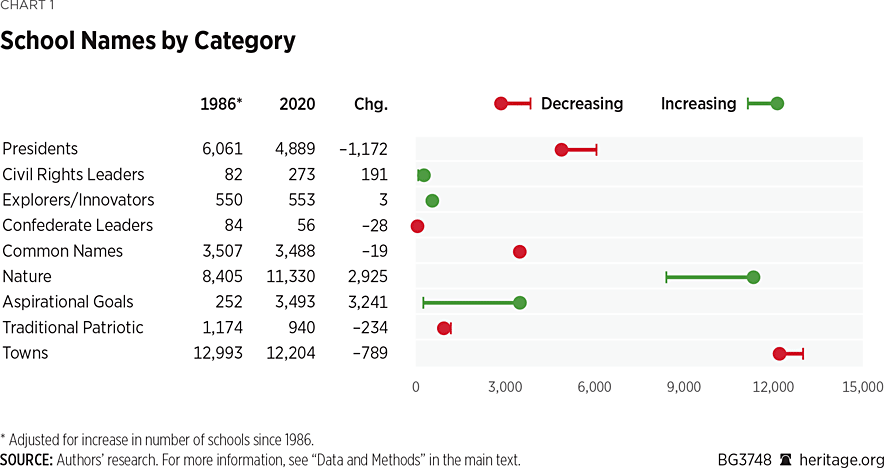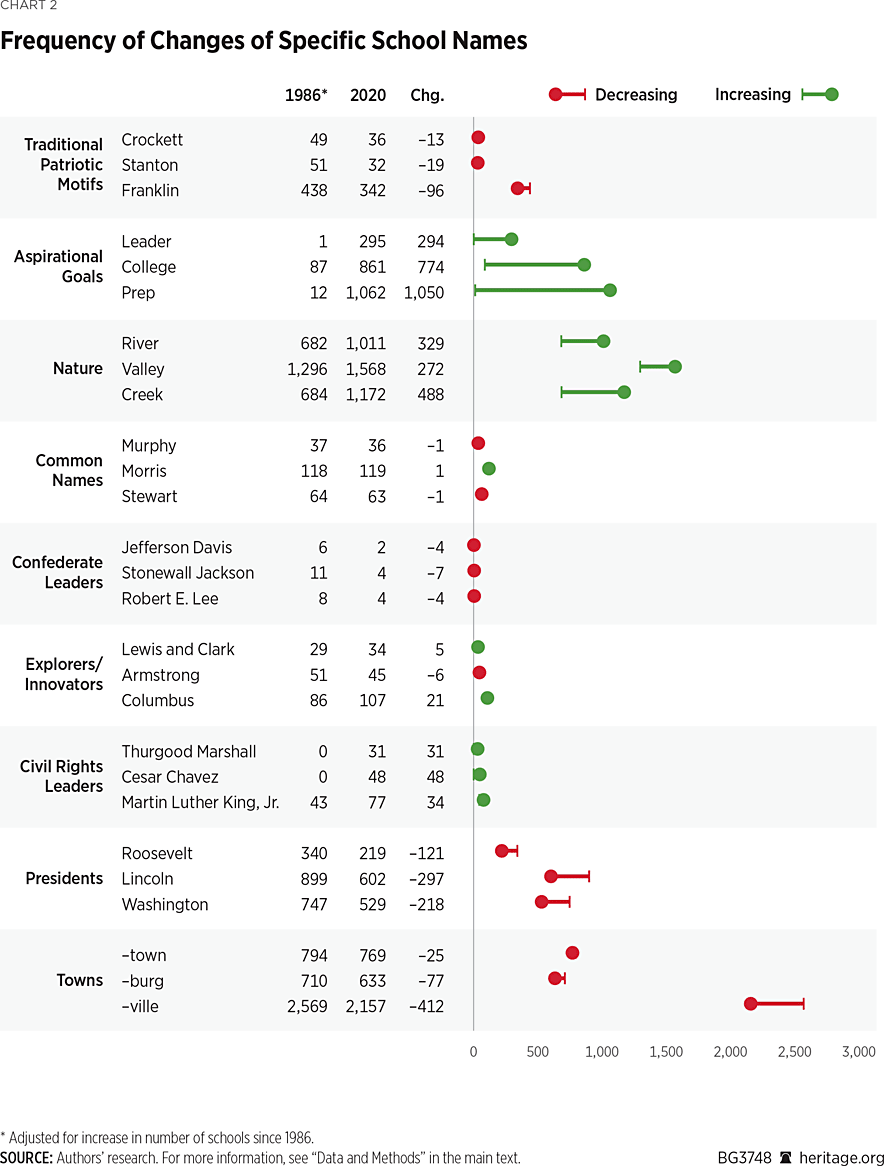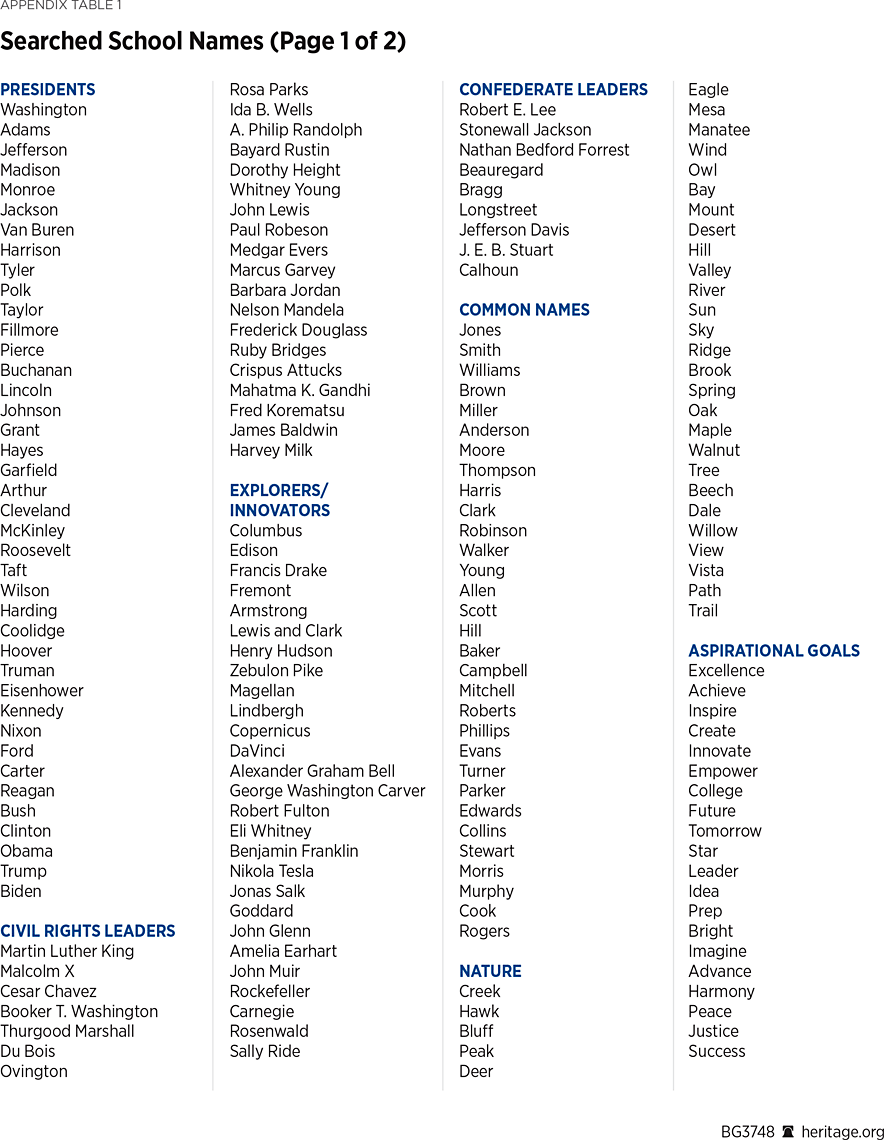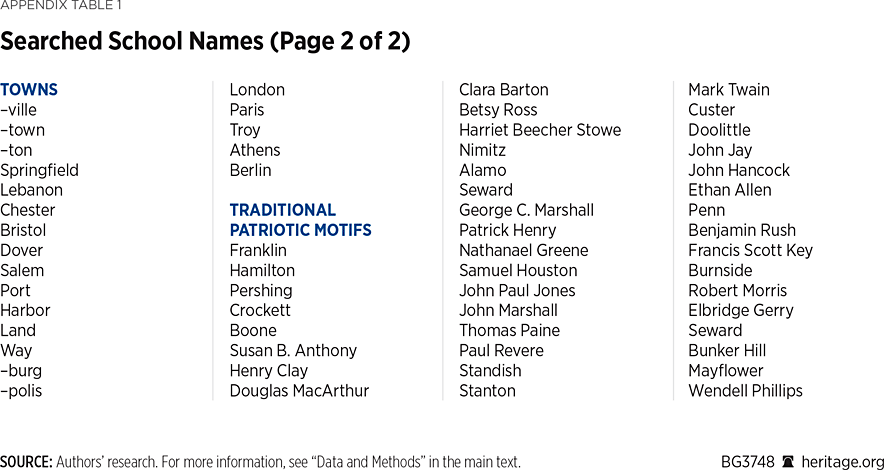What is in a school name? When communities name schools, they are communicating to the public, very much including children, which values they hold dear. Naming schools, like naming other public spaces, such as streets, buildings, and parks, is an opportunity for communities to declare what or who should be honored. It could be a person, a place, an idea, or a thing, but whatever name is selected says something about what a community considers important.
Observing trends in school names can demonstrate how the values and priorities of the country’s public education system have changed over time. To analyze those trends, we examine the 83,420 names of public schools in the 1986–1987 school year and compare them to the 99,568 names of public schools in the 2020–2021 school year.
We find a sharp decline in schools named after American presidents. There has also been a marked decrease in naming schools after people who could be classified as representing traditional patriotism, including the Founders, generals, and American folk heroes. If the change in school names reflects a broader change in values, the decline in presidents’ and traditional patriotic school names suggests that patriotism is not a priority in today’s schools.
Despite the fact that more schools are now named after civil rights figures who call on Americans to live up to the county’s ideals, the number remains vanishingly small—and does not come close to compensating for the decline in schools named after historical patriotic figures, such as presidents and generals.
And, while there has been a decline in schools named after Confederate leaders and generals, their numbers are so small in 1986 and 2020 that they make practically no difference in the overall pattern.
As patriotic school names are in sharp decline, what kind of names have been taking their place? The biggest increase in school names has occurred among those featuring nature and aspirational abstractions. That is, many more schools are named after creeks, valleys, trees, and animals as well as many more that have names containing terms, such as “excellence,” “achievement,” and “innovation”—for example, the Academy for Excellence in Leadership in Brooklyn, NY, or the Accelerated Achievement Academy in Hollister, CA.
School names are more likely to sound like herbal teas or day spas (Whispering Wind Academy in Phoenix, AZ) or motivational posters (the Achievement, Integrity, and Maturity school in Alexandria, VA) than like the country’s Founders (“George Washington Middle School” or “Benjamin Franklin High School”).
This Backgrounder explores these and other trends in school names and considers what these decisions indicate about the values and priorities of the American public education system.
Data and Methods
The information on school names comes from the U.S. Department of Education’s National Center for Education Statistics. We obtained the names of all public schools for the 1986–1987 as well as 2020–2021 school years. We then conducted searches for specific school names or fragments of names that would capture variants of a similar name. In total, we searched for 225 names that grouped into nine categories: (1) Presidents, (2) traditional patriotic motifs, (3) nature, (4) aspirational goals, (5) civil rights leaders, (6) Confederate leaders, (7) common names, (8) explorers and innovators, and (9) towns. A complete set of the 225 names in those nine categories are found in Appendix Table 1.
We then searched for and counted the number of schools in both 1986 and 2020 that matched these names. Because there was a 19.4 percent increase in the number of schools between 1986 and 2020, we adjusted all 1986 tabulations by multiplying them by 1.194. This avoids distorting trends in school names that arise from the overall increase in schools. All numbers attributed to 1986 in this Backgrounder have been adjusted in this way.
The 225 names for which we searched and the nine categories in which they are grouped are not meant to be an exhaustive list of all school names or possible names within each category. The searched names are simply intended to be representative enough to reveal meaningful trends. In total, our searches for these 225 names captured 37,226 schools, more than 37 percent of all school names in 2020, assuming that they are not duplicative.
There is some amount of imprecision in this approach. For example, searching for the name “Clinton” yields schools named after President Bill Clinton, as well as after the signer of the Declaration of Independence, George Clinton. Two Presidents have the name Johnson, but so do various educators, local politicians, and others for whom schools have been named. Our approach does not allow us to adjudicate how many of those Clintons or Johnsons are named after Presidents versus others. But by searching for a large and diverse set of school names, the big trends we have observed are likely to dwarf the imprecision of each individual search.
Results: Categories with Meaningful Changes
1. Presidents. The most dramatic decline between 1986 (adjusted for the change in the total number of schools) and 2020 is in the number of schools with Presidents’ names. In 1986, 6,061 schools (adjusted) were bestowed with the surname of a President. In 2020, that number dropped to 4,889, a decrease of 1,172 schools. The largest decline occurred among schools with the name Lincoln. In 1986, the adjusted number of Lincoln schools was 899, but in 2020 there were only 602—a decline of 297. Schools with the name Washington also declined sharply, from 747 in 1986 (adjusted) to 529 in 2020, a difference of 218. The third-largest drop was in Jefferson schools, falling by 141 from 574 in 1986 (adjusted) to 433 in 2020. The fourth-biggest decline in schools with Presidents’ names was among Roosevelt schools, which dropped by 121 from 340 in 1986 (adjusted) to 219 in 2020.
Some Presidents’ names became more common, but they are largely confined to the Presidents who were in office, or still in office, after 1986. There are now 36 Reagan schools, 64 Bush schools (whether George H. W. or George W.), and 24 Obama schools. Despite the addition of these more recent Presidents, the total number of schools with Presidents’ names still dropped substantially. That decline is not confined to Presidents who were slave holders. Schools named after Lincoln, the Great Emancipator, declined by the largest amount among all Presidents. Roosevelt, whether Theodore or Franklin, was also not protected by the relatively good standing that both Roosevelts have with historians across the political spectrum. Despite their mainstream respectability, there has been a marked decline in the number of schools that carry the Roosevelt name.

2. Traditional Patriotic Motifs. Another category that saw large declines was among schools named after traditional patriotic motifs, such as the Founders (exclusive of Presidents), generals, American folk heroes, and famous battles. The number of schools with one of the 40 names in this category fell from an adjusted 1,174 in 1986 to 940 in 2020, a drop of 234. There are 342 schools with the name Franklin, as of 2020, which is 96 fewer than the 438 (adjusted) that existed in 1986. Despite the widely celebrated musical, schools named Hamilton decreased from 164 in 1986 (adjusted) to 154 in 2020. Paul Revere was on the name of seven schools in 1986 (adjusted), and only four in 2020. American folk heroes Davy Crockett and Daniel Boone also saw declines—for Crockett from 49 in 1986 (adjusted) to 36 in 2020, and for Boone from 58 in 1986 (adjusted) to 53 in 2020.
Generals also began to disappear from school names. John Pershing, the commander of the American Expeditionary Force during World War I, was on the name of 39 schools in 1986 (adjusted) but only 29 in 2020. George Custer, the general who led the doomed attack on Indian tribes at Little Bighorn, has clearly fallen out of favor, dropping from 45 schools in 1986 (adjusted) to 24 in 2020. The Civil War general and later three-time governor of Rhode Island, Ambrose Burnside, was on 11 schools in 1986 (adjusted) but only four in 2020.
3. Nature. As patriotic school names, like those honoring Presidents, Founders, generals, and folk heroes, have declined, there has been a dramatic increase in schools named after natural features, such creeks, ridges, valleys, and animals. There were 684 schools with names including the word “creek” in 1986 (adjusted), and by 2020 the number had spiked to 1,172. School names containing the word “ridge” more than doubled from 247 in 1986 (adjusted) to 597 in 2020. “River” schools increased from 682 in 1986 (adjusted) to 1,011 in 2020. Schools including “deer,” “hawks,” “owls,” and “eagles” in their names grew from 449 in 1986 (adjusted) to 566 in 2020. School names including “view,” “vista,” “path,” or “trail” climbed from 968 in 1986 (adjusted) to 1,448 in 2020. In total, an additional 2,925 school names honored natural features in 2020, rising from 8,405 in 1986 (adjusted) to 11,330.
4. Aspirational Goals. The other category of school names that has grown dramatically includes those emphasizing aspirational goals, such as excellence, innovation, success, leadership, and college preparation. The fragment “prep” was only in 12 public school names in 1986 (adjusted). By 2020 that number had ballooned to 1,062 “prep” schools. For 1986, we could find no schools featuring “excellence,” “innovation,” “empower,” “tomorrow,” or “imagination” in their names. In 2020, 396 schools had one of these terms in their names. Schools with names honoring “achievement,” “inspiration,” “creativity,” future,” “leadership,” “idea,” “advance,” “peace,” “justice,” and “success” shot up from 38 in 1986 (adjusted) to 906 in 2020. Overall, the number of aspirational school names rose from only 252 in 1986 (adjusted) to a staggering 3,493 in 2020.

Results: Categories without Meaningful Significant Changes
5. Civil Rights Leaders. While traditional patriotic school names are in steep decline, there has not been a commensurate rise in schools named after newer patriotic figures, such as civil rights leaders. In 1986, only 86 schools (adjusted) were named after prominent civil rights figures. That number rose, but only to 273 in 2020. That increase of 191 schools did not come close to offsetting the decline in schools named after Presidents, Founders, generals, and traditional American folk heroes.
Even Martin Luther King, Jr., who has a federal holiday in his honor, had relatively few public schools named for him in both 1986, when there were 43 schools (adjusted), and 2020, when there were 77. There were no schools named after Cesar Chavez in 1986, but there were still only 48 in 2020. Civil rights lawyer Thurgood Marshall, the first black Supreme Court Justice, who was on the Court in 1986, did not yet have any schools named in his honor at that time, and by 2020 that number had risen to only 31.
Rosa Parks went from having two schools named after her in 1986 to only 25 in 2020. Frederick Douglass had his name on only 22 schools in 2020, up from six (adjusted) in 1986. Among 90,000 public schools, very few are named for civil rights figures, and the trend in this category makes little difference in overall patterns.
6. Confederate Leaders. The disappearance of schools named after Confederate leaders may make headlines, but not many schools were named for them to begin with, so the decline in this category makes little difference. In total, schools honoring Confederate leaders dropped from 84 in 1986 (adjusted) to 54 in 2020. Only eight schools had the name “Robert E. Lee” in 1986 (adjusted). That number dropped to four in 2020. “Jefferson Davis” was the name of only six schools in 1986 (adjusted), falling to two in 2020. There were only 11 Stonewall Jackson schools in 1986 (adjusted), which declined to four in 2020. While there is clearly a movement away from schools named after Confederate leaders, their numbers had already been small for a generation or more.
7. Common Names. Based on prior research,REF we suspected that naming schools after people in general was in decline. To test this proposition, we searched for 31 of the most common surnames that are not also the names of Presidents. These common surnames include names such as Jones, Smith, Williams, Brown, and Harris. To the extent that schools named for local teachers, superintendents, politicians, and other people are captured, it should be possible to observe a trend in naming schools after people, in general, by searching for these common surnames. We found virtually no change in the number of schools with these common surnames. There were 3,507 in 1986 (adjusted) and 3,488 in 2020. It appears that the decline in schools named after traditional patriotic figures does not extend to a drop in naming schools after other people.
8. Explorers and Innovators. We also suspected that, just as traditional patriotic school names were in decline, there might be a similar decline in schools named after explorers and innovators. We did not, however, notice any meaningful change in this category of school names: 550 schools were named after explorers and innovators in 1986 (adjusted), and 553 in 2020. To our surprise, schools with Columbus in the name increased from 86 in 1986 (adjusted) to 107 in 2020. Schools named for Thomas Edison dropped from 154 in 1986 (adjusted) to 124 in 2020, but those named for George Washington Carver rose from five in 1986 (adjusted) to 25 in 2020. There were 34 Lewis and Clark schools in 2020 compared to 29 in 1986 (adjusted), but the number of Neil Armstrong and John Glenn schools fell from 67 in 1986 (adjusted) to 56 in 2020. Some names gained and some names lost, but there was no clear overall pattern in this category of school names.
9. Towns. Many schools are named after the towns in which they are located. The number of school names in this category appears to have dropped, but it is unclear that this reflects a meaningful change in values or priorities. We searched for 20 common town names, including fragments, such as “ville,” “town,” and “burg,” to capture a large number of place names. In total, the number of schools containing these town names or fragments fell from 12,993 in 1986 (adjusted) to 12,204 in 2020.
While this appears to be a significant drop, as for traditional patriotic school names, the change may be an artifact rather than a meaningful trend. As population density in towns has increased, school districts that previously had only one elementary, middle, and high school named after the place, would need to find new names as they added schools. Unless they relied entirely on adding directional names, such as North, South, East, West, or Central, subsequent school names would likely honor things other than the town name.
Results: Switching or Replacing School Names
School names could change over time because existing schools switch the name, or because the kinds of names on schools that close are replaced with different kinds of names for the new schools that open. We suspect that the process by which school names are changing resembles how people’s first names have been changing over time. Noting that old-fashioned first names, like Bertha or Abner, are disappearing does not mean that people who were born as Bertha and Abner are legally changing their names. It is more likely that as people with those kinds of names are dying, babies are being given different names.
To examine this question, we were able to look at the 2020 names of schools that also existed in 1986. While we did not systematically examine all names, it is clear that very few of the school names that have been in sharp decline are disappearing because names are being switched. For example, only 22 schools named after Lincoln that existed in 1986 switched their name to something other than Lincoln. The disappearance of Lincoln schools was largely caused by old schools bearing his name being closed while new schools were opened with different names.
The same pattern holds true for Washington, where only nine schools honoring the first President disappeared due to changing the name on a continuing school. The only exception to this pattern appears in the decline in schools named for Custer, which was almost entirely driven by Custer schools switching names while no new Custer school opened.
If focusing on debates over whether names of existing schools should be changed, as many news analyses of this issue tend to do, one misses the bigger trends in school names. School names are not becoming more or less common because of high-profile fights over switching names. Instead, the changes are occurring quietly as school boards close schools with certain names and open new schools with other names.
Why are patriotic names, such as of Presidents, the Founders, and non-Confederate generals, disappearing from schools while nature and aspirational names are becoming more common? These trends may reflect a change in the broader culture, but we believe that they reveal more about the shift in the priorities of local school boards.
According to a recent review of decades of polling on American patriotism produced by the American Enterprise Institute, there has not been a marked decline in patriotism in the U.S. since the 1980s.REF The results fluctuate across different questions asked by different pollsters, but other than a spike in patriotic sentiment around 2001, there has not been a dramatic change in how connected Americans feel toward their country. For example, a Pew survey asked participants in a national sample every year between 1987 and 2012 whether they agreed with the statement, “I am very patriotic.” Between 1987 and 1990, an average of 48.25 percent “completely agreed.” Between 2007 and 2012 an average of 52.25 percent completely agreed. A Gallup survey showed that 78 percent reported being “very proud” to be an American in 1981, dropping to 73 percent in 2000. After changing the answer options, the Gallup survey found that 55 percent reported being “extremely proud” to be American in January 2001 compared to 51 percent in 2017. Americans as a whole continue to love their country at about the same rate in recent years as they did four decades ago.
It is important to remember that school boards, not voters or parents, typically select school names. While Americans, in general, have not abandoned patriotism, school boards have become much more reluctant to give schools traditional patriotic names. School boards may have more closely resembled the patriotic preferences of the communities they serve in the past than they have more recently.
A growing disconnection between the values favored by communities and those favored by school boards may flow from a change in the political benefits of serving on a school board. In the past, when control over education was more decentralized, school boards had much more extensive influence over what happened in local schools. As education policy and funding has become more centralized in state capitals and Washington, DC, school board members have less autonomy over school policies. This development likely shifted, on average, the type of people attracted to serve on school boards. Where school boards would have once drawn community leaders focused on school operations, they increasingly attract people who view school boards as a stepping stone to running for other elected offices.
As Alan Ehrenhalt described in his classic book, United States of Ambition, local elected positions, like school board member, have become the farm system for aspiring politicians hoping to make it into the big leagues of higher office.REF As school boards turned into the training ground for higher elected office, Ehrenhalt observed that it shifted those attracted to serve in those local elected positions to the left, since a long political career tends to be more appealing to those on the left. In addition, as serving on a school board became a stepping stone to higher office, board members would become more cautious for fear of jeopardizing future prospects.
Giving schools patriotic names requires some political courage today, not because patriotic names are generally unpopular, but because a vocal minority (often from outside a given school district) finds them objectionable. Most Americans tend to like patriotic school names, but some may object to honoring any given patriotic figure. By contrast, no one is particularly excited about naming schools after creeks, trees, animals, or excellent achievement, but no one is likely to object to these nature and aspirational names. Risk-averse school board members with ambitions for higher office are simply more likely to take the inoffensive path of giving schools names that sound like herbal teas or day spas than to give them potentially controversial patriotic names, no matter how unfounded that controversy may be.
The political career ambitions of school board members, however, come at the expense of the civic purpose of school names. Giving schools patriotic names may be an important tool for helping to maintain and foster patriotism in current and future generations. Patriotic figures can also serve as models of civic virtue. To restore the civic purpose of giving schools patriotic and other meaningful school names, voters may need to undo the incentives that currently attract budding politicians to school boards. It may not take much political courage to give a school a patriotic school name, but voters are currently falling short of finding enough school board members who can muster even that minimal fortitude.
Jay P. Greene, PhD, is Senior Research Fellow in the Center for Education Policy at The Heritage Foundation. Ian Kingsbury, PhD, is a Senior Fellow at the Educational Freedom Institute.



